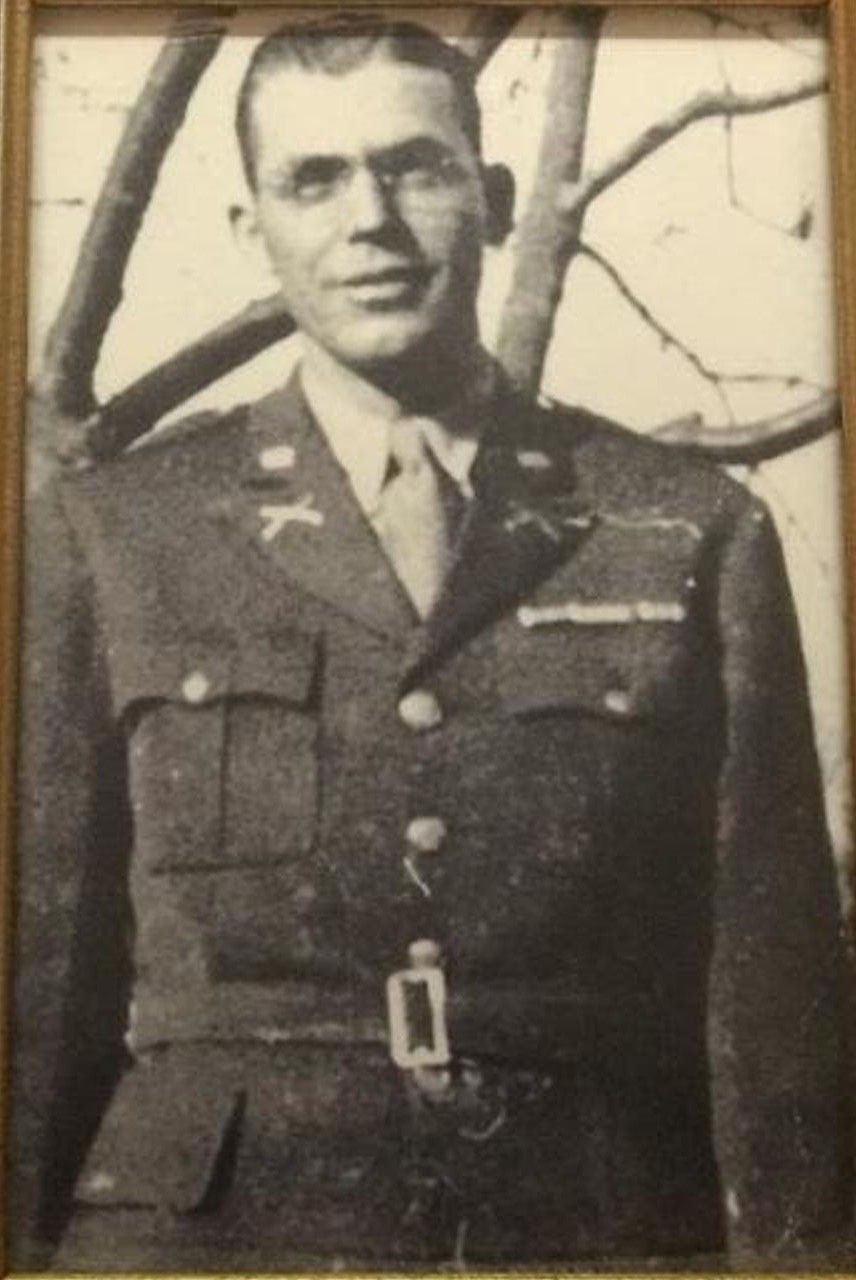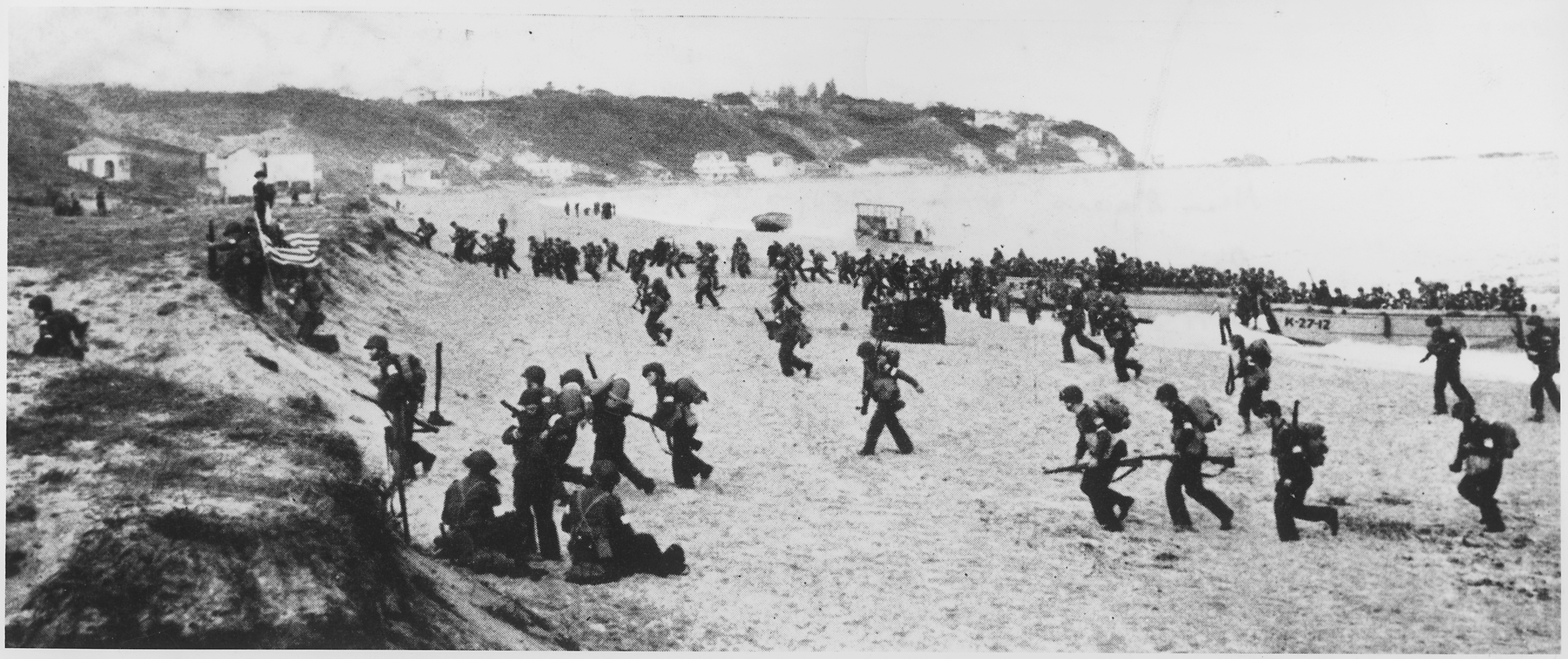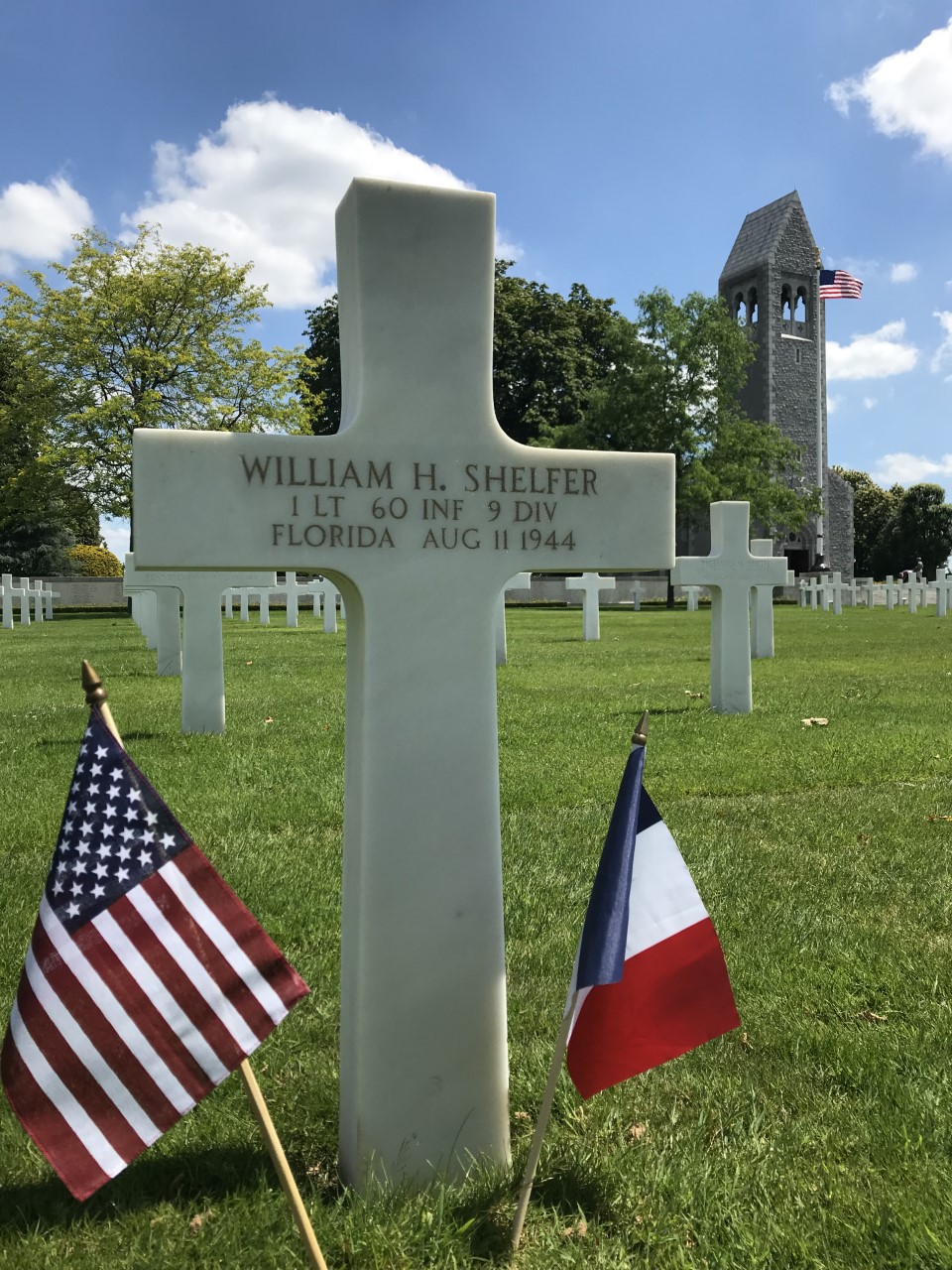First Lieutenant William Howard Shelfer

- Unit: 9th Infantry Division, 60th Infantry Regiment, Company B
- Service Number: O-1288797
- Date of Birth: October 23, 1917
- Entered the Military: October 16, 1940
- Date of Death: August 11, 1944
- Hometown: Havana, Florida
- Place of Death: near Mortain, France
- Award(s): Purple Heart with two Oak Leaf Clusters , Purple Heart
- Cemetery: Plot D, Row 10, Grave 3. Brittany American Cemetery, Saint-James, France
Leon High School
2018-2019
Early Life
Born on October 23, 1917, and raised in the quiet tobacco town of Havana, Florida, William “Howard” Shelfer was the youngest of four surviving children to Charles and Eva Howard Shelfer. While in his early teens, Shelfer’s mother became ill and died. Howard and his father moved in with Howard’s older brother, Charles Jr., and his wife, Sara Elizabeth Thompson.
Although quite precocious, Shelfer did not complete high school. He was “aghast at the low quality of students graduating,” and dropped out during tenth grade. As a young man, Shelfer worked on Edmund H. Corry’s tobacco farm in Quincy, Florida, developing a love of fine cigars and chewing tobacco. He spent many of his free hours memorizing poetry and furthering his math skills— of which, he was quite adept. He perpetually carried a slide rule and a book of his favorite poems wherever he went.
Military Experience
Training
Shelfer enlisted on October 16, 1940, and began training at Camp Blanding, Florida, in February 1941. As a result of his high marks, he was selected to attend Officer Training School in Fort Benning, Georgia. He began officer training in spring 1942, where he continued to excel.
Before his transfer, he married Ruth Eileen Tourtellot on January 1, 1942, in Orlando, Florida. The couple met while Private Shelfer was on leave and, although surprised by this sudden decision, his family welcomed Eileen into their close circle. He wrote home as often as he could find the time and maintained frequent correspondence with his wife, father, sister, brother, and sister-in-law throughout his military career.
Lieutenant Shelfer
In July 1942 Shelfer graduated from Fort Benning and transferred to Fort Bragg, North Carolina. There he became a platoon commander and supply officer for the 115th Infantry Regiment. His correspondence indicated that he took his role as supply officer very seriously and deeply felt the responsibility for his men’s safety. By mid-August, the unit received deployment orders, and Shelfer spent three rough weeks at sea traveling from New York to Morocco with Company B of the 60th Infantry Regiment of the 9th Infantry Division.
A Purple Heart in North Africa
On November 8, 1942, the U.S. military launched Operation Torch to liberate the North African coast. Landing in eight transports at 5:30 a.m., 40 minutes late and in high seas under the command of Major John H. Dilley, Shelfer’s mission was specific to Operation Goalpost, a subset of the larger operation.
His objective was to take and hold the Port Lyautey airport, six miles south of the landing site at Mehdia in French Morocco (now Morocco). His unit, the 2nd Battalion of the 60th Regimental Combat Team, landed after sunrise. They met heavy resistance from the German-aligned French Vichy air and ground troops. who had been alerted earlier through a short-wave broadcast to North African Resistance by President Franklin D. Roosevelt.
Shortly into the mission and under heavy shelling from French forces, Shelfer was shot in the center of the left thigh and lost a great deal of blood. His attacker attempted to discharge a second bullet, but Shelfer was faster and shot him first. However, due to an inexplicable mix-up, his wife and brother received official telegrams from the adjutant general shortly before Christmas stating that he had been killed in action in French Morocco.
His father wrote numerous letters to the government requesting the details of his son’s death and, on December 29, another military telegram arrived. This one confirmed that Shelfer was alive and recovering from his wound in a hospital in North Africa. Mail service had been delayed, and the numerous letters Shelfer wrote in the hospital did not arrive in Florida until New Year’s Day 1943.
Tunisia
By early December 1942, Shelfer had sufficiently recovered to return to the 60th Infantry Regiment. In mid-January 1943, the 47th Infantry Regiment temporarily joined forces with the 60th Infantry Regiment to protect the British Prime Minister Winston Churchill and U.S. President Franklin Delano Roosevelt during the Casablanca Conference.
Allied leaders determined that Tunisia was to be the primary military target, and the fight to liberate the Italian stronghold commenced. Shelfer and the 60th Infantry Regiment marched towards Tlemcen, Algeria and then pushed through to reinforce Kasserine Pass with the 9th Infantry Division. From there, the 60th Regimental Combat Team, including Shelfer, detached from the remainder of the 9th Infantry Division and marched to Djebel Goussa, Tunisia to defend the rail line to the sea.
During the following 20 days of the Battle of Maknassy in March 1943, Shelfer demonstrated his skill as a leader and creative problem solver. When the 60th Infantry Regiment was trapped under heavy German artillery, food and ammunition ran low. Shelfer captured a few local mules to create a make-shift caravan and shuttled supplies over the mountain for almost two miles of treacherous terrain to reinforce the men. A letter home shortly afterward indicates that he was awarded a battlefield promotion and a silver star for his efforts. However, official military records do not indicate that the medal itself was actually bestowed. Shelfer and the 60th Infantry Regiment joined the rest of the company in El Guettar, Tunisia in late March.
From there, the 9th Infantry Division pushed continued the push towards Bizerte, Tunisia. There Shelfer and the other members of the 2nd Battalion earned the division’s first Presidential Unit Citation for their actions during the fierce Battle of Sedjenane, specifically at Djebel Dardyss, on April 23-24, 1943. For four days they were surrounded by German troops, taking heavy artillery fire in almost impassable foliage and on steep slopes. Shelfer’s caravan-method of supply delivery was employed to reinforce their position and eventually American batteries out-shelled the surprised German forces. This experience haunted Shelfer and he described in vivid detail the sounds of “mountains shooting mortar and exploding artillery shells at his men” that troubled his dreams.
Upon leaving the Sedjenane Valley on April 28, the 60th Infantry Regiment continued the march to Bizerte. The city fell on May 9 before their arrival. Over the next two months, Shelfer and other veterans of the 60th Infantry Regiment trained green reinforcements for an amphibious assault on Sicily and enjoyed some rest.
A New Purple Heart in Sicily
The Allied Operation Husky commenced on July 9, 1943, in an attempt to liberate Europe through the Italian peninsula. Shelfer and the 60th Infantry Regiment entered the conflict on July 31, landing in Palermo, Sicily. Intense fighting occurred and, although the Germans were rapidly retreating, the pursuit was fraught with booby traps, mines, shell craters, and live ammunition all the way to Serra Del Ray. Shelfer’s correspondence described how his company lost “more men than any other in the regiment.” In a very near miss, three grenades exploded around him, creating a narrow triangle that somehow spared his life, while killing many of the soldiers nearby. Later in the day, his glasses were shot off his face, shattering glass into his eye, but miraculously preserving his vision. This injury garnered Shelfer a second Purple Heart.
A Welcome Break
With the fall of Messina, Italy on August 14, 1943, Shelfer spent many hours writing to his family, updating them about his experiences in the war, and asking about life at home. It was clear that he was tiring of the constant conflict and missed his family immensely.
What he did not share was the mischief he got into while abroad.
Shelfer built a reputation as a blackjack player and was described as the “greatest morale-booster the 60th ever had.” He fished with grenades to serve his men dinner. He posed as a private to steal turkeys meant for the brass’ Christmas dinner and served them to his men.
Most humorous was an account by fellow Lieutenant Pat Weldie who claimed that, while their ship was taking heavy German fire in Palermo Harbor and they were preparing their platoons to disembark, Shelfer yelled over all the noise for him to come over quick. Shelfer said, “Hey Weldie, have you noticed how dangerous it is?” Understanding the severity of the situation, Weldie replied, “We could get a bomb in our laps!” To this, Shelfer’s retort was, “That ain’t it – this last batch of replacements! My God, we’re surrounded by Yankees!” And they were. The new artillery recruits were a notorious group of New Englanders with thick Boston accents.
Unfortunately, there was little time for Lieutenant Shelfer to get into trouble in Sicily, as the orders to embark to Winchester, England arrived in early November. Thanksgiving was spent traveling the Atlantic, and the winter preparing for the next stage of the war: Operation Overlord.
Time in England
The long, cold, dark days of the British winter did very little to lift the spirits of Lieutenant Shelfer. He enjoyed the snow and found the locals charming, but he missed home. Military brass visited the 9th Infantry Division that winter: General Omar Bradley presented the Distinguished Unit Citation to Shelfer and the 2nd Battalion on December 2, and General Dwight Eisenhower and Prime Minister Winston Churchill inspected the troops on a visit to Winchester in February. Apart from this, the cold months were generally quiet.
In March 1944, Shelfer was temporarily released from Company B and placed on Colonel McCauley’s staff as an S-4 Logistics Advisor, presumably for the organization and preparation of matériel for Operation Overlord. Shelfer had a great deal of respect for the Colonel and referred to him as “the smartest man [he] ever knew.”
But the impending invasion started fraying the war-worn lieutenant. He spent more time playing blackjack and lost close to $400 gambling and drinking during a weekend furlough in May. He had an extended love affair with a young and beautiful British dentist, and his young wife, Eileen, was “scandalously” offered a job as a professional dance teacher. His spring letters home held a darker tone, and he expressed both the futility of war and his unlikely prospects of ever returning home.
Normandy
The hardened veterans of the 9th Infantry Division were held in reserve for the complex military operations anticipated following D-Day. Shelfer and the 60th Infantry Regiment arrived on Utah Beach on D+4 (June 10, 1944) and immediately set about the task of “breaking out” of Normandy. Fighting amongst the bocage (hedgerows) was fierce and slow. The 60th Infantry Regiment joined other units in the dangerous push north and west to cut off the Cotentin peninsula from German reinforcements. By late June, Shelfer and his division reached Cap de la Hague, northwest of Cherbourg, France, successfully completing their mission.
The Last letter
The 9th Infantry Division received reinforcements and a respite in the first week in July while they trained on new equipment. Right before the drive to the division’s next objective began on July 9, Shelfer sent off a short letter to his family.
July 5, 1944 Once again we have counted our dead and gone into a rest area. We will be here only for a short time, but that is alright because we are not getting any rest anyway.-Howard P.S. I am beginning to wonder if I have a right to live.
Operation Cobra and a Final Purple Heart
Shelfer moved south towards the city of Saint-Lô with the 9th Infantry Division. From there, they were incorporated into Operation Cobra, the U.S. mission to break out of Normandy to liberate France. On July 25, Allied planes dropped over 3,000 tons of bombs outside Saint-Lô to clear the path for ground troops, inadvertently shelling the front line of the 9th Infantry Division. Shelfer was spared and continued the Allied advance to the south. The German counterattack, Operation Luttich, brought intense fighting between the 9th Infantry Division and desperate German infantry regiments and panzer divisions. By August 10, the conflict reached the town of Mortain, France. The Germans continued their retreat to the south and east, and the 60th Infantry Regiment halted for the evening.
Shelfer drove in hot meals for the troops that evening and selected an exposed location to set up, confident that there would be no more fighting that day. In an unexpected shelling, Shelfer and his unit chaplain, First Lieutenant Irving Tepper, dove for cover under one of the trucks. The vehicle was struck and exploded, killing Shelfer instantly.



Eulogy
Unfortunately, many of the details of Lieutenant Shelfer’s service have been lost as a result of the National Personnel Records Center fire in 1973, which incinerated 80% of the U.S. Army files from World War II.
It is assumed that he was buried in a temporary grave in or near Mortain until the permanent Brittany American Cemetery was established in Saint-James, France after the war. There, he was laid to rest among the other 4,000+ fallen soldiers who perished in Operation Cobra.
Those who survived Lieutenant Shelfer looked to preserve his memory; they saved his letters, wrote a war memoir, interviewed veterans who knew him, erected a marker in the family cemetery in Havana, Florida and visited his grave in Brittany. His widow, Eileen, remarried years later and started a family with her new husband. However, she saved her correspondence with “Howard” for the greater part of 50 years to preserve her memories of their time together. She valued his sense of humor, his intelligence, and enjoyed their shared love of poetry. The content of these letters will remain forever private as they were eventually destroyed in the 1990s.


Reflection
Bibliography
9th Infantry Division; World War II Operations Reports, 1940-1948, Records of the Adjutant General’s Office, Record Group 407 (Box 6344); National Archives at College Park, College Park, MD.
9th Infantry Division; World War II Operations Reports, 1940-1948, Records of the Adjutant General’s Office, Record Group 407 (Box 6508); National Archives at College Park, College Park, MD.
Allied Invasion of France. Wearied by house to house fighting in a French coast town…. Photograph. June 10, 1944. National Archives and Records Administration (111-SC-190125-3). Image.
Beckers, Yuri. “9th Infantry Division” 9thinfantrydivision.net. Last modified 2018. Accessed December 3, 2018. 9thinfantrydivision.net/
“Brittany American Cemetery and Memorial.” American Battle Monuments Commission. Accessed March 15, 2019. www.abmc.gov/sites/default/files/publications/Brittany_Brochure_ Feb2018.pdf.
Florida. Gadsden County. 1920 United States Federal Census. ancestry.com.
Florida. Gadsden County. 1930 United States Federal Census. ancestry.com.
Florida. Gadsden County. 1940 United States Federal Census. ancestry.com.
Comtois, Pierre. Operation Torch: Sub-Task Force Goalpost Capture Port Lyautey. World War II Magazine, November 1996.
Garland, Albert N. and Smyth, Howard M. The Mediterranean Theater of Operations: Sicily and the Surrender of Italy. Center of Military History, United States Army: Washington DC, 1993. history.army.mil/html/books/006/6-2-1/CMH_Pub_6-2-1.pdf.
Henry, Thomas. “The Avenging Ghosts of the Ninth.” The Octofoil. November/December 1961. 9th Infantry Association newsletter.
Infantry Bn. Advances up a hill…. Photograph. May 7, 1943. National Archives and Records Administration (111-SC-173126). Image.
Mittleman, Joseph B. Eight Stars to Victory. The Ninth Infantry Division Association, Washington DC, 1948.
Morgan, Mary-Howard Shelfer. Personal interview. March 3, 2019.
Morgan, Mary-Howard Shelfer. Personal interview with J.P. Foley. March 28, 1995.
Morgan, Mary-Howard Shelfer. Personal interview with Sergeant Reed Vassar. July 18, 1995.
Near Algiers, “Torch” troops hit the beaches behind a large American flag… Photograph. November 8, 1942, ” National Archives and Records Administration (195516). Image.
Overy, Richard (Editor). The New York Times Complete World War II 1939-1945: The Coverage from the Battlefields to the Home Front. Black Dog and Leventhal Publishers, Inc. New York, NY, 2013.
Phillips, Henry Gerard. Sedjanane, the Payoff Battle: Leading to the Capture of Bizerte, Tunisia, by the 9th U.S. Infantry Division, May 9, 1943. Self-published, Penn Valley, CA, 1993.
Shelfer Family Photograph. 1944. Courtesy of Morgan Family.
“William Howard Shelfer.” American Battle Monuments Commission. Accessed October 22, 2018. www.abmc.gov/node/420273
William Howard Shelfer to Charles Boatman Sr. June 27, 1943. Courtesy of Ruth Shelfer.
This profile was researched and created with the Understanding Sacrifice program, sponsored by the American Battle Monuments Commission.

